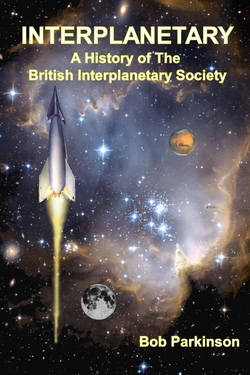Centauri Dreams
Imagining and Planning Interstellar Exploration
Cometary Dust Around ??Pictoris
New findings from the Herschel space observatory demonstrate how effective the infrared telescope can be at teasing out details of distant planetary systems. At issue is the system around Beta Pictoris, a young star (12 million years old) some 63 light years from the Earth. We’re looking at planetary system formation in progress here, with a single gas giant planet and a dusty debris disk that may be the forerunner of a disk much like our own Edgeworth/Kuiper Belt, the collection of icy bodies that orbits outside the orbit of Neptune.
Ben de Vries (KU Leuven) is lead author of the paper on the new Herschel data, which examines the composition of dust in the outer regions of the Beta Pictoris disk. The study, reported today in Nature, presents a photometric and spectral analysis of dust particles produced when planetesimals in this region collide. The key player here is olivine, a mineral associated with protoplanetary disk material around newborn stars. The olivine found around Beta Pictoris is similar to that found in the dust of primitive Solar System comets.
Herschel has been detecting a magnesium-rich variety of olivine at a distance of 15-45 AU from the star. While olivine can crystallize out of protoplanetary disk material, it eventually becomes part of larger bodies, from comets to asteroids and planets. Usefully, the two states of olivine can be distinguished from each other, as de Vries explains in this ESA news release:
“As far as olivine is concerned, it comes in different flavours. A magnesium-rich variety is found in small and primitive icy bodies like comets, whereas iron-rich olivine is typically found in large asteroids that have undergone more heating, or ‘processing’.”
Moreover, finding olivine in the cold debris disk is itself a marker, for the mineral can only crystallize within about 10 AU of the star. The de Vries team assumes that radial mixing processes are at work, produced not only by stellar winds and heat from the central star but by temperature differences and turbulence in the protoplanetary disk itself. The Herschel data show that olivine crystals make up 3.6?±?1.0 percent of the total mass of the dust found in this outer region, a figure similar to the Solar System comets 17P/Holmes and 73P/Schwassmann-Wachmann 3, according to de Vries.
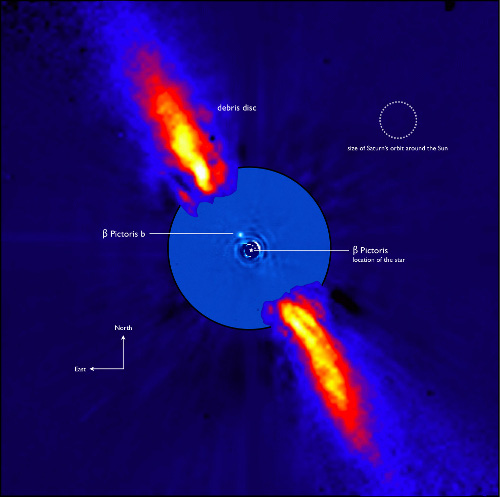
Image: Infrared view of the Beta Pictoris solar system, obtained by combining data from the ADONIS instrument on ESO’s 3.6 m telescope (outer regions) and the NACO instrument on one of the 8.2 m units of ESO’s Very Large Telescope (inner region), and then subtracting the overpowering glare of the central star. The image shows a planet orbiting at roughly the same distance from Beta Pictoris as Saturn is from our own Sun, and a prominent dust disc in the outer reaches of the system. New observations from ESA’s Herschel space telescope have found magnesium-rich olivine crystals in the disc that likely originated from collisions between comets: the dust shares the same compositional characteristics as in several comets in our Solar System. Furthermore, the observation of these olivines in the outer dust disc suggest that they have been transported from their birthplace close to the central star, since they cannot form under the cold conditions found further out. Credits: ESO/A-M. Lagrange et al.
The findings are helpful because they point to basic processes of planetary system growth. Beta Pictoris is one and a half times as massive as the Sun and eight times as bright, but the radial mixing process at work here looks to be roughly the same as that postulated for the early Solar System. Measuring residual materials from an early exoplanetary system is an impressive feat and a reminder of Herschel’s capabilities. Launched in 2009, this is the first observatory to span the entire range from far-infrared to submillimeter wavelengths, pushing deeper into the far infrared than any previous mission. Meanwhile, Beta Pictoris continues to be an ideal ‘laboratory’ for watching a young system grow. It doubtless has much more to teach us.
The paper is de Vries et al., “Comet-like mineralogy of olivine crystals in an extrasolar proto-Kuiper belt,” Nature 490 (04 October 2012), pp. 74-76 (abstract).

Remembering “Men Into Space”
Yesterday’s discussion about Man Will Conquer Space Soon!, the landmark series in Collier’s that so elegantly defined the 1950s view of space travel, has me in a retrospective mood. The Collier’s series was highly visible, and those old enough to have seen it tend to remember its concepts whether or not they’re in an aerospace-related profession today. But a few years later a TV show called “Men Into Space” turned up on CBS, fighting for audience share and generally out-publicised by the network’s “Twilight Zone” offering. It would run only a single season and end in September of 1960, months before Yuri Gagarin’s daring ride in a Vostok.
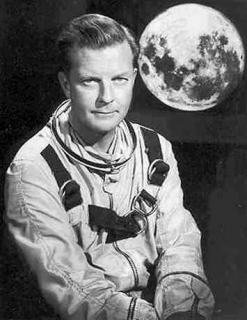
But “Men Into Space” sticks with me for a reason. Its 38 episodes followed Col. Edward McCauley (played by William Lundigan) through a variety of space situations, using him as a viewpoint character while the astronauts he worked with dealt with breakthroughs and problems. In that sense there was a certain similarity to what would become the Mercury program — we can assume this is exactly what the producers had in mind — but in its relatively realistic view of the dangers of these missions, it also harked back to the era of the rocket plane, when test pilots flew the X-15 and its X-series predecessors to new speed and altitude records.
Image: William Lundigan, star of “Men Into Space,” who portrayed a seasoned astronaut guiding an often-changing cast through the dangers of manned spaceflight. Credit: Ziv Television Productions.
It’s that dual emphasis that makes this series interesting. Back in 2003 when I was researching Centauri Dreams in Cleveland, I was headed out to lunch with Marc Millis and Geoff Landis. This was not long after the Columbia disaster and the idea of risk — and its ability to paralyze the space program — was very much in the air. I quoted Landis on this in the book:
“If a test pilot crashes at Edwards Air Force Base…they name a street after him, and the next day someone else flies another mission to see what went wrong. With space, things are different. Every mission has to be a success, we can tolerate no casualties. It may be a cultural thing. Maybe we’ve grown too afraid of risks.”
My thought was that it’s not the people in the machines who fear the risks but the culture that sends them, and in that I agreed with Landis. But these retrospective thoughts about space in the media have me wondering just why — and when — the risk paradigm changed. If you read Tom Wolfe’s The Right Stuff, you’ll recall the mindset that Wolfe identified at Edwards, where Chuck Yeager cracked the sound barrier in the X-1 and Scott Crossfield pushed the X-15 to every limit in the book (Crossfield is famous for saying that the X-15 was one of the few aircraft that caused grown men to cry when it was summarily retired). Wolfe is worth quoting on the idea of risk and how it looked in the late 1950s, when “Men Into Space” was made.
As to just what this ineffable quality was…well, it obviously involved bravery. But it was not bravery in the simple sense of being willing to risk your life. The idea seemed to be that any fool could do that, if that was all that was required, just as any fool could throw away his life in the process. No, the idea here…seemed to be that a man should have the ability to go up in a hurtling piece of machinery and put his hide on the line and then have the moxie, the reflexes, the experience, the coolness, to pull it back in the last yawning moment — and then to go up again the next day, and the next day, and every next day, even if the series should prove infinite — and, ultimately, in its best expression, do so in a cause that means something to thousands, to a people, a nation, to humanity, to God. Nor was there a test to show whether or not a pilot had this righteous quality. There was, instead, a seemingly infinite series of tests…
“Men Into Space,” in a post-Sputnik America that was about to go crazy with the idea of going to the Moon, pushed its astronauts into a variety of Moon landings, space station scenarios, the building of a Moon base and two different attempts to reach Mars. The two Mars missions failed and they were not alone, for this was a show where astronauts occasionally died. Things went wrong and, unlike Neil Armstrong and David Scott’s dangerous Gemini 8 flight, which could easily have proven fatal, many of the “Men Into Space” missions lost their crews. Technical glitches were common and astronauts kept going back into space in spite of all this.
I’m an old movie buff and I particularly enjoy the depiction of aviation in movies of the 1930s and 1940s. Recently I was watching Pat O’Brien and Humphrey Bogart in “China Clipper” (1936), in which a turbo-charged Bogart pushes O’Brien’s new clipper design to the limit, flying through an advancing squall line to demonstrate that the design had what it took to survive the Pacific. Pilots died aplenty in the early days of aviation and it was considered part of the price for learning how to build better aircraft, an approach that fed directly into the culture Wolfe describes at Edwards. It’s an attitude that feeds countless aviation films of this era.
Something happened to our cultural risk paradigm between the late 1950s and the end of Apollo, something that was certainly with us when we lost our two Space Shuttles, and I’m wondering just what it was. My guess is that the rocket-plane pilots of Edwards Air Force Base were never in the public eye to the extent that the Mercury 7 were, and that our decision to mount a national effort to reach the Moon in the context of the Cold War elevated our crews into the kind of public figures whose loss would be unthinkable. The risks of these flights were palpable, but the risk paradigm — what we all felt about those flights and those crews — seemed to be changing.
I suspect that if we do enter into a time of commercial space development, with companies like Planetary Resources actually mining asteroids with human crews launched by SpaceX or other companies, the paradigm will begin to shift again. Sheer numbers will eventually force it to, for a large enough population working on a regular basis in space is a different thing than a single crew facing long odds on a dangerous mission. The show that prompted these musings, “Men Into Space,” doesn’t seem to be available in streaming mode, but I do see various DVDs out there. Like the Collier’s series, it’s an interesting illustration of how our thinking on space has changed.

Collier’s: Gorgeous Art, Breathtaking Ideas
In the course of an enjoyable dinner with Douglas Yazell, Shen Ge and Al Jackson (this was in Houston at the 100 Year Starship Symposium), I learned that the Houston section of the American Institute of Aeronautics and Astronautics was in the process of reprinting, in its entirety, the famous Collier’s series on manned spaceflight. Yazell is editor of Horizons, the bi-monthly publication of the Houston group, and fortunately for all of us, it is both online and free. For me, revisiting these stirring articles will be a priority as each comes out. The July/August issue contains Collier’s for March 22, 1952, first in the series.

I can only imagine how this issue of Collier’s would have drawn the eye in the typical early 1950s newsstand. The Chesley Bonestell cover shows an enormous winged rocket staging as it soars above an Earth flecked with cloud and crimson with distant sunlight. Evidently we have Scott Lowther to thank for scanning and repairing the entire Collier’s series, a fact he reports on his Unwanted Blog, where he notes that this is the first time these articles have been republished in full-color, high-resolution format since their original release. He does point out that some of the numerous original ads have been edited out — Horizons has replaced these with ads from its Collier’s team members.
According to notes offered by Yazell, Collier’s flagged the upcoming series — to be called Man Will Conquer Space Soon! — with a press release on March 13, 1952, previewing the six articles, totalling 25 pages, that would comprise the first installment of the series. In all, eight issues of the magazine, running into 1954, would offer space articles. Magazine collectors know that UNZ.org has offered the Collier’s series for some time (along with a huge amount of other magazine material), but the UNZ.org scans are low-resolution. The Horizons work restores the series in sharp, gorgeous color.
Space Seizes the Public Imagination
What an impact this series had on the imagination of readers at the time, for not only were the articles written by major figures in the scientific community, including Wernher von Braun, Willy Ley, Fred Whipple and others, but the magazine made liberal use of the illustrations of Chesley Bonestell in addition to fine (and too often neglected) artwork from Rolf Klep and Fred Freeman, not inconsiderable artists in their own right. It’s the Bonestell most people remember first, though, and many young people went on to have these concepts ingrained through three episodes in the Disneyland TV series that were based on the Collier’s concepts.
Physicist A. A. Jackson goes so far as to say, in this same issue of Horizons, that the Collier’s series may have made the Apollo program a reality by influencing countless young people to pursue careers in spaceflight. It certainly, five years before Sputnik, seized the public imagination, a possibility von Braun’s friend Willy Ley must have foreseen when he took the idea for the project to Cornelius Ryan, then an editor at Collier’s. The series drew liberally from material von Braun had developed for a science fiction novel he called Project MARS: A Technical Tale, whose appendix would become the basis of a space series in a German spaceflight journal. Von Braun’s Mars novel would eventually find an English publisher and it remains in print through the University of Illinois Press.
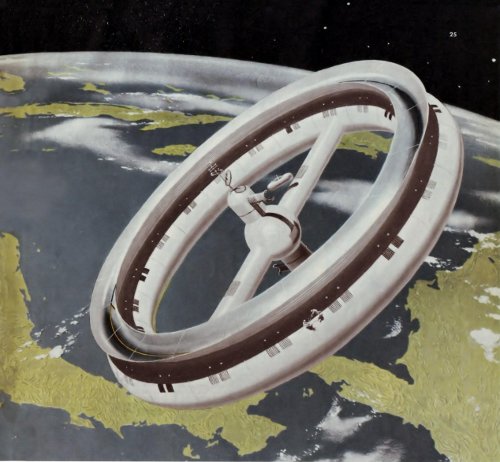
Image: Chesley Bonestell’s space station distilled earlier science fiction concepts into a vivid image that would recur in 1950s SF films like Conquest of Space (Bonestell did background space art for the movie, which also tapped von Braun’s ideas). Credit: Collier’s.
If you want to see what space as a goal felt like in the early 1950s, take a look at these pages, where the excitement is palpable and the technology seemed just around the corner. So many of the tropes of the era’s science fiction films had their genesis here, as witness not just von Braun’s winged rockets but the enormous wheel of a space station being serviced by tiny space taxis, the latter rendered in detailed cross-section by Fred Freeman’s talented brush. Bonestell’s painting of a manned lunar orbiter, with its three bulbous chambers connected by scaffolding, captures the wonder of a first glimpse of the far side of the Moon and a soon to be burgeoning space race caught up in the geopolitics of the Cold War. The Collier’s editors were careful to position space as an arena for a competition the US could not afford to lose. From their introduction:
When the atomic bomb program — the Manhattan Project — was initiated, nobody really knew whether such a weapon could actually be made. The famous Smyth Report on atomic energy tells us that among the scientists there were many who had grave and fundamental doubts of the success of the undertaking. It was a two-billion-dollar technical gamble.
Such would not be the case with a space program. The claim that huge rocket ships can be built and a space station created still stands unchallenged by any serious scientist. Our engineers can spell out right now (as you will see) the technical specifications for the rocket ship and space station in cut-and-dried figures. And they can detail the design features. All they need is time (about ten years), money and authority.
Coming up next in the Horizons reprint series is the October 18, 1952 issue of Collier’s, devoted to the Moon and the attempt to land humans on it. The editorial of that issue notes that an expanded version of the March 22nd articles had already appeared as a book called Across the Space Frontier from Viking Press, a sure indication of the surge in interest the magazine had created. It also mentioned the Third International Congress on Astronautics, which had just met in Stuttgart, where a von Braun paper was read. For many, the Collier’s series took science fiction into the realm of engineering reality, matching vivid space imagery with ongoing scientific research. It was a mind-bending, career-changing journey whose pages repay our continued attention.

SPACE: A Personal Vision
by Shen Ge
Coming up this January is a two-week long “minds-on ties-off” research workshop at Callao Salvaje on Tenerife on the Canary Islands. I learned about the organization behind the workshop — the Scientific Preparatory Academy for Cosmic Explorers — in Houston when I had the good fortune to have dinner with its young co-founder Shen Ge. Shen’s organization is a nonprofit academic and research corporation created by young people from many countries. It began this year with a July conference on the Isle of Man, and will soon enter what it considers Phase 1: Building educational modules for brief space courses that can be taught at the university level. The ultimate goal is an actual university with full-time faculty and students. I asked the energetic Shen if he could supply us with a brief article outlining his vision and the steps ahead.
In some respects, Shen’s ideas parallel those of the International Space University, as he notes below, although he hopes to extend their reach. The ISU is a non-profit institution offering graduate-level training from a central campus in Strasbourg, France, with a two-month Space Studies Program and a one-year Masters program covering space programs and enterprises, space science, space engineering, systems engineering, space policy and law, business and management, and space and society. More than 3300 students from 100 countries have had ISU training, developing a network of space professionals that Shen hopes to enrich and extend.
I’ve recently been asked to comment on my vision for our Scientific Preparatory Academy for Cosmic Explorers, or SPACE, an organization of which I am a co-founder. There currently exists no such entity as SPACE in the world and there needs to be if humanity is ever to become a spacefaring civilization. My vision is of an international, interdisciplinary, and hands-on research and educational university where anyone with a passion for space and a decent academic record will be welcomed to join our institution to learn and research space topics.

From recent surges in space development, whether they are publicly funded by governments in rapidly developing nations such as China or India aiming for prowess or whether they are started by young upstarts backed by wealthy entrepreneurs such as Planetary Resources or Space X aiming for profits, there is no denying that space will play a vitally important role for all of us on Earth. Just as we cannot imagine today a world without airplanes flying people everywhere for business or leisure, in the next few decades we will live in a world where we could not imagine people not taking space trips to space colonies, the asteroids or the Moon.
Yet for us to reach that point, we need more people with both the knowledge and interest in a discipline that can propel humanity into a spacefaring civilization. When I look back at my own experience, I’m a little disappointed. I obtained a good education in aerospace engineering but I found three important areas missing in my programs:
1) No core focus on space. This is completely understandable since aerospace engineering also delves deeply into aircraft. There currently exists no multidisciplinary space educational university for the undergraduate. There are aerospace engineering programs around the world but many of them are not related to space or are heavily specialized in one area.
2) Lack of other classes related to space that were not engineering-oriented. Many new discoveries are made from cross-disciplinary studies. Yet at engineering schools, we are required to take so many engineering classes that we inevitably cannot learn much of other interesting fields. We are advocating a multidisciplinary space education that includes topics such as astronomy, astrophysics, computer science, astrophysics, space law, space commerce etc. in a 4-year educational curriculum.
3) Lack of research opportunities directly related to space. Unless the student lands an internship or enters a co-op working for a space company, actual space research is limited to a handful of professors. And as mentioned above, much of the research actually being performed in the aerospace engineering department is still geared towards aircraft. We seek research that emphasizes the skills and knowledge needed by those who will explore the cosmos.
The International Space University (ISU) is a needed step towards creating an educational entity that revolves around space and offers more than a single discipline such as aerospace engineering can provide. Conversations among ISU professors and alumni such as Christopher Stott, Chris Welch, Adil Jafry, and Virgiliu Pop helped all of us realize that even ISU is missing something. It is missing the educational pipeline that lies before it. The people who seek to go into ISU have already obtained at least a 4-year education elsewhere, often in a field not related to space.
We decided with the understanding support from ISU personnel that the establishment of SPACE will substantially complement the established ISU. Our goal: To build an international space academy that will complement the existing International Space University (ISU) by providing a four-year university of space studies. This will endow the people with the skills and mentality to go to the stars and go there to stay.
In my vision, I see the next five years for SPACE as an arduous path of overcoming initial skepticism and establishing our dream in physical reality. Chris Welch affectionately called us “Dreamers 3.0” (ISU was co-founded by Dreamers 2.0) at his presentation at our inaugural conference earlier this July [2012] but I would like to say that we’re more than “Dreamers.” We are “Do-ers” as well.
We lack tens of million dollars to build our institution (although we would certainly be glad for the help of any rich benefactors to our cause). Hence, we are building up our reputation via events such as the upcoming January SPACE Retreat on Tenerife, our annual conference in July, and our upcoming educational modules to teach our space design and sociology courses at universities around the world. We are concurrently conducting research on asteroid mitigation, space imaging, and space trajectories for which we will publish papers and present at conferences.
Through our activities as “Do-ers 3.0,” I see enough attention drawn to our cause in the next five years from both the wealthy and the population at large that we will be able to secure the funds needed to build our campus and research buildings here on Earth. Hopefully, in my lifetime, we will have satellite campuses on space stations in orbit, on asteroids, and on the Moon as well. Our fundamental thesis is that exploration is education, and that scholarly instruction and research are merely two aspects of discovery. The ultimate goal of SPACE is to help build a space-faring society.
Shen Ge received his Masters in aerospace engineering from Texas A&M University in 2011 August and received his undergraduate with a dual major in aerospace engineering and physics with Magna Cum Laude in 2008 December from Georgia Institute of Technology. His background is in space design, space simulations, and experimental design. He has great interest in manned space exploration, near earth asteroids, and space debris. His work on his Masters was on designing an innovative payload for a near earth asteroid mitigation mission. He also has interest in space entrepreneurship and public engagement of space-related endeavors. He is currently actively spearheading SPACE as a nonprofit international undergraduate and graduate space university and research institution.

Lowering Life’s Chances on Super-Earths
Super-Earths are exciting finds. The more of them we discover, the more likely it seems that life is abundant in the cosmos. But new work examining the viscosity and melting temperature of mantle rock is casting a different aura over super-Earths. Rather than being planets much like the Earth but simply more massive — worlds characterized by thick atmospheres, plate tectonics, volcanic activity and magnetic fields — they may differ in fundamental ways. With internal pressures tens of times higher than those found in Earth’s interior, large viscosities and melting temperatures could have adverse consequences on the planet’s habitability.
The potential effects extend as far as the core of the planet, which may not even exist. In a presentation at the European Planetary Science Congress on September 26, Vlada Stamenkovic (Massachusetts Institute of Technology) noted that the average super-Earth may in fact be undifferentiated; i.e., it may not have separated into a metallic core and a rocky mantle:
“Current understanding is that the terrestrial planets in our solar system formed rapidly — in about the first 50 million years. The time scale of core formation depends strongly on viscosity. The high melting temperatures and the large viscosities that we’ve calculated for super-Earths suggest either a slow core formation or no core formation at all. This raises doubts about whether super-Earths could generate magnetic fields.”
Without a liquid metallic core, a magnetic field that could play a role in protecting the atmosphere from solar particles would be unlikely. Moreover, plate tectonics are not inevitable on a super-Earth, a phenomenon that, along with volcanic activity, can play a role in regulating the climate during ice ages. Stamenkovic and team are looking at the effect of volcanic outgassing and the production of molten rock, which they believe decline with increasing planetary mass.
“Our work highlights the importance of understanding the thermal evolution of planets — moreover, it shows that super-Earths are more diverse than expected. We will only be able to fully answer questions by gathering more data from high-pressure experiments and from spectroscopic observations of super-Earth atmospheres orbiting close-by bright stars. Theory shows the possibilities, which are far larger than previously thought, but remains full of uncertainties,” said Stamenkovic.

Image: A super-Earth like the one in this artist’s conception can grow twice as large as Earth with up to 10 times the mass. But would its thermal evolution make it a likely candidate for life? Credit: David A. Aguilar (Harvard-Smithsonian/CfA).
Even in a differentiated super-Earth, the researchers found that heat flow from the core can be limited by stagnant layers forming deep in the mantle, with conduction instead of convection becoming the primary form of heat transport, which would reduce the cooling rate of the core. We lack the data to make the call, but easy assumptions about super-Earths and habitability now have to contend with robust alternative scenarios.
Two papers coming out of this work are available: Stamenkovic, et al., “The influence of pressure-dependent viscosity on the thermal evolution of super-Earths,” Astrophysical Journal, 748:41 (20 March 2012) and Stamenkovic et al., “Thermal and transport properties of mantle rock at high pressure: Applications to super-Earths,” Icarus 216 (2011), 572-596. More in this European Planetary Science Congress news release.

Pluto, Charon and Kepler
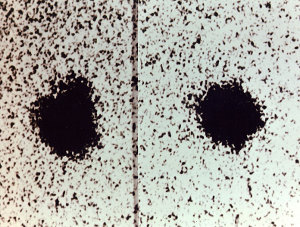
Our view of Pluto/Charon gets better and better as we prepare for the New Horizons flyby in 2015. It wasn’t so long ago that we had no idea Pluto had a single moon, much less the five we have so far identified. When James Christy (USNO) discovered Charon in 1978, he was looking at photographic plates of Pluto that showed little more than a slight bulge that appeared periodically. The bulge came into and out of view as the [dwarf] planet rotated, indicating a genuine object and not a flaw in the observation, but although Charon had been found, we couldn’t resolve separate disks until the Hubble Space Telescope’s images of the 1990s.
Image: Plates taken with the Kaj Strand Astrometric Reflector at the USNO Flagstaff Station in Arizona revealed the existence of Charon, visible as an elongation in the image. Later eclipses and occultations of Pluto and Charon confirmed the discovery. Charon has a mass of about 22 percent that of Pluto. Credit: Wikimedia Commons.
The Hubble images, unlimited by distortions from Earth’s atmosphere, have revealed much about Pluto/Charon. But take a look at another image, this one taken with the Gemini North 8-meter instrument. This is said to be the sharpest ground-based imagery of Pluto/Charon ever taken in visible light. These observations have not only verified the orbital characteristics of the two objects but are sharp enough to reveal their precise diameters. Steve Howell (NASA Ames), who led the study, says “The Pluto-Charon result is of timely interest to those of us wanting to understand the orbital dynamics of this pair for the 2015 encounter by NASA’s New Horizons spacecraft.”
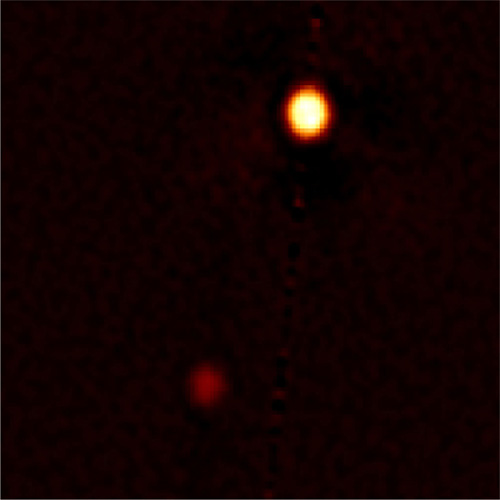
The technique being used here is called reconstructive speckle imaging, made possible through mounting a camera called the Differential Speckle Survey Instrument (DSSI) onto the telescope. Using these methods, a large number of short exposure images are processed to remove the effects of atmospheric distortion. Each image was exposed for 60 milliseconds. Over the range of images, the light from the objects under observation could be separated from the transient artifacts caused by the atmosphere. The DSSI instrument and associated software were created by Elliott Horch (Southern Connecticut State University) and team in 2007. Detectors for the instrument were upgraded in late 2009, making possible the new levels of sensitivity shown here.
Image: Speckle image reconstruction of Pluto and Charon obtained in visible light at 692 nanometers (red) with the Gemini North 8-meter telescope using the Differential Speckle Survey Instrument (DSSI). Resolution of the image is about 20 milliarcseconds rms [root mean square]. This is the first speckle reconstructed image for Pluto and Charon from which astronomers obtained not only the separation and position angle for Charon, but also the diameters of the two bodies. North is up, east is to the left, and the image section shown here is 1.39 arcseconds across. Credit: Gemini Observatory/NSF/NASA/AURA.
Reconstructive speckle imaging is showing its stuff with Pluto/Charon, but the bigger picture is that the upgraded DSSI can be used in the exoplanet hunt. Kepler’s transit studies require follow-ups from other instruments to confirm the discoveries, and the original DSSI had been in use at Kitt Peak for this purpose. NASA’s Howell says that speckle imaging with the Gemini telescope will double the instrument’s ability to resolve objects, offering a 3- to 4- magnitude sensitivity increase for the sources the team needs to observe. The astronomer calls it “an enormous gain in the effort underway to confirm small Earth-size planets.”

